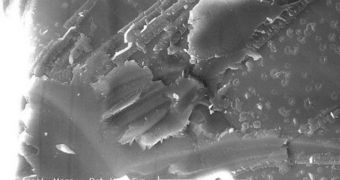Scientists from the NASA Johnson Space Center (JSC) recently announced that a new study they conducted on a famous Martian meteorite found in 1996 lends further credence to the fact that ancient life existed at one point on Mars. The space rock has been a cause for Discord in the international scientific community since it was first discovered, and many groups have argued either for or against it containing sings of past Martian life. Using modern techniques, the JSC team determined that early life remains the most plausible explanation for the structures identified in the rocks, ScienceDaily reports.
What's interesting about this new work is that it did not focus directly on studying the ancient meteorites. Instead, the group analyzed the studies that proposed the structures found in the space rocks were not signs of life. Their results are very clear – other origins than lifeforms are not plausible for these particular samples. The investigation comes 14 years after another JSC team, led by scientists David McKay, Everett Gibson and Kathie Thomas-Keprta, published a paper in the highly-regarded journal Science, claiming the discovery of biogenic evidence in the meteorite known as ALH84001.
The recent paper, entitled “Origin of Magnetite Nanocrystals in Martian Meteorite ALH84001,” again revisits the same old hypothesis, but adds additional data to support the claims. Details of the data appear in the November issue of the journal Geochimica et Cosmochimica Acta of The Geochemical Society and The Meteoritical Society, and is authored by Thomas-Keprta. Coauthors include experts Simon Clemett, McKay, Gibson and Susan Wentworth, who are all based at the JSC Astromaterials Research and Exploration Science Directorate.
“In this study, we interpret our results to suggest that the in situ inorganic hypotheses are inconsistent with the data, and thus infer that the biogenic hypothesis is still a viable explanation,” reveals Thomas-Keprta, who was the lead author of the investigation. He is also a JSC senior scientist for Barrios Technology. “We believe that the biogenic hypothesis is stronger now than when we first proposed it 13 years ago,” adds Gibson, who is a senior scientist at the American space agency.
“The evidence supporting the possibility of past life on Mars has been slowly building up during the past decade. This evidence includes signs of past surface water including remains of rivers, lakes and possibly oceans, signs of current water near or at the surface, water-derived deposits of clay minerals and carbonates in old terrain, and the recent release of methane into the Martian atmosphere, a finding that may have several explanations, including the presence of microbial life, the main source of methane on Earth,” says McKay, who is the JSC chief scientist for exploration and astrobiology.

 14 DAY TRIAL //
14 DAY TRIAL //